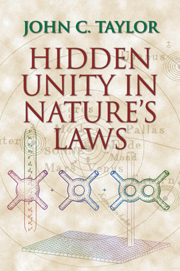Book contents
- Frontmatter
- Contents
- Preface
- 1 Motion on Earth and in the Heavens
- 2 Energy, Heat and Chance
- 3 Electricity and Magnetism
- 4 Light
- 5 Space and Time
- 6 Least Action
- 7 Gravitation and Curved Spacetime
- 8 The Quantum Revolution
- 9 Quantum Theory with Special Relativity
- 10 Order Breaks Symmetry
- 11 Quarks and What Holds Them Together
- 12 Unifying Weak Forces with QED
- 13 Gravitation Plus Quantum Theory – Stars and Black Holes
- 14 Particles, Symmetries and the Universe
- 15 Queries
- APPENDIX A The Inverse-Square Law
- APPENDIX B Vectors and Complex Numbers
- APPENDIX C Brownian Motion
- APPENDIX D Units
- Glossary
- Bibliography
- Index
APPENDIX A - The Inverse-Square Law
Published online by Cambridge University Press: 20 January 2010
- Frontmatter
- Contents
- Preface
- 1 Motion on Earth and in the Heavens
- 2 Energy, Heat and Chance
- 3 Electricity and Magnetism
- 4 Light
- 5 Space and Time
- 6 Least Action
- 7 Gravitation and Curved Spacetime
- 8 The Quantum Revolution
- 9 Quantum Theory with Special Relativity
- 10 Order Breaks Symmetry
- 11 Quarks and What Holds Them Together
- 12 Unifying Weak Forces with QED
- 13 Gravitation Plus Quantum Theory – Stars and Black Holes
- 14 Particles, Symmetries and the Universe
- 15 Queries
- APPENDIX A The Inverse-Square Law
- APPENDIX B Vectors and Complex Numbers
- APPENDIX C Brownian Motion
- APPENDIX D Units
- Glossary
- Bibliography
- Index
Summary
Newton's law of gravitation (Section 1.7) has an inverse-square dependence on the distance. Double the distance means a quarter the force, and so on. This particular dependence on distance (as opposed to, say, an inverse cube or some other rate of decrease) has several special features, which I will explain in this appendix.
First of all, there is an interesting mathematical analogy with another physical situation. I stress that it is only an analogy: it is not meant to be a physical explanation of gravity, or anything like that.
The analogous situation is this. Imagine a large tank of still water. In the middle, put a small device near the center that sucks out water at a steady rate. (See Figure A.1.)
Where the water goes does not concern us: we can imagine it being drawn out through a narrow pipe that does not significantly interfere with the rest of the water in the tank. As a consequence of sucking out of the water, there must be a flow of water from distant parts of the tank towards the device, which I shall henceforth call (for want of a better word) an extractor. We also want to arrange that the sucking action of the extractor is the same in all directions. Then the flow in the tank will be the same in all directions. We want to work out the speed at which the water in the tank is flowing towards the extractor, and in particular how this speed depends upon the distance from it. Imagine any sperical surface in the fluid with its centre at the extractor.
- Type
- Chapter
- Information
- Hidden Unity in Nature's Laws , pp. 431 - 436Publisher: Cambridge University PressPrint publication year: 2001



